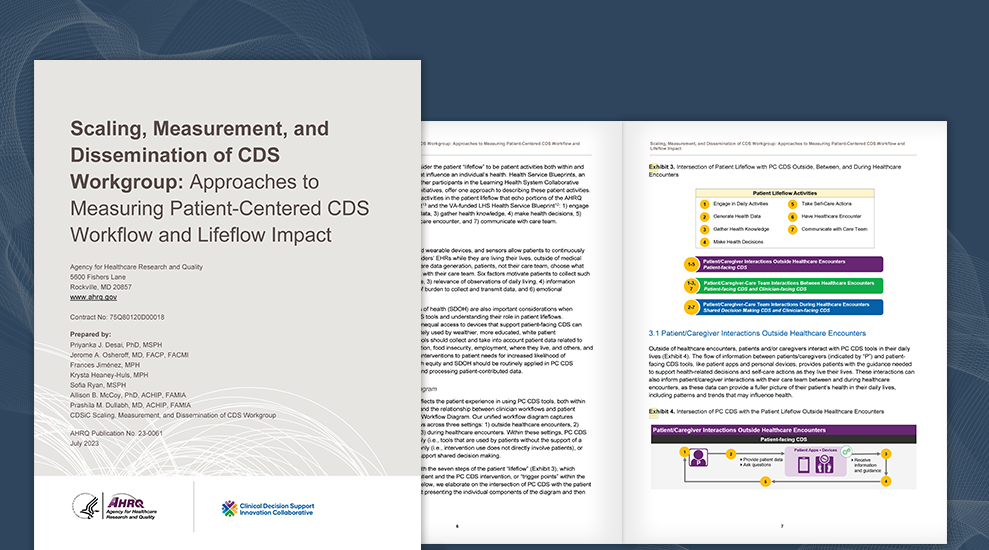
This report examines how patient-centered CDS interventions impact care team workflows and patient lifeflows.
Developed by the AHRQ CDSiC Scaling, Measurement, and Dissemination of CDS Workgroup, this report summarizes workflow and lifeflow impacts captured in the literature and provides a framework to help identify the optimal point for a patient-centered CDS tool’s deployment in a patient's lifeflow.
To be effective, patient-centered clinical decision support (PC CDS) interventions must fit smoothly into clinical workflows and patients' daily activities (i.e., “lifeflows”). For example, CDS that does not fit comfortably into clinical workflows may contribute to low user acceptance and uptake of the decision support (e.g., evidence-based recommendation), leading to unintended consequences and suboptimal decisions and care. Similarly for patients, if patient-facing decision support does not adequately consider and address not only their medical data and preferences but also real-world contexts, then health management solutions informed by the decision support will not properly accommodate the daily-living contexts in which they occur. In addition to summarizing workflow and lifeflow impacts that are captured in the literature, this report provides a framework for how PC CDS interventions impact care team workflows and patient lifeflows.
About the Report
This report is based on a scoping review of peer-reviewed literature relevant to care team workflow impacts and patient lifeflow impacts resulting from CDS usage. Findings from the literature were supplemented with key informant interviews.
The report focuses on three distinct types of PC CDS: 1) patient-facing CDS, 2) clinician-facing CDS, and 3) CDS for shared decision making, and provides a unified workflow diagram that accounts for both patient/caregiver lifeflows and care team workflows, illustrating how patients’ activities and decisions are both influenced by and influencers of clinical workflows. The diagram includes three workflow types:
- Patient/Caregiver Interactions Outside Healthcare Encounters
- Patient/Caregiver-Care Team Interactions Between Healthcare Encounters
- Patient/Caregiver-Care Team Interactions During Healthcare Encounters
The report also outlines measure concepts and measurement approaches that are currently used to assess workflow and lifeflow impacts of PC CDS interventions, including:
- Workflow Context
- Uptake
- Use
- Subjective Value
How to Use This Report
This report’s framework can help identify interactions between care teams and patients and caregivers and the PC CDS intervention, or “trigger points” within the clinical workflow and the patient lifeflow. This can help users:
- Consider the context of patients’ lives when developing PC CDS tools and interventions and where key activities intersect with care team workflows.
- Optimally deploy PC CDS interventions within the patient lifeflow.
Suggested Citation: Desai PJ, Osheroff JA, Jiménez F, Heaney-Huls K, Ryan S, McCoy AB, Dullabh PM, CDSiC Scaling, Measurement, and Dissemination of CDS Workgroup. Scaling, Measurement, and Dissemination of CDS Workgroup: Approaches to Measuring Patient-Centered CDS Workflow and Lifeflow Impact. Prepared under Contract No. 75Q80120D00018. AHRQ Publication No. 23-0061. Rockville, MD: Agency for Healthcare Research and Quality; July 2023.





